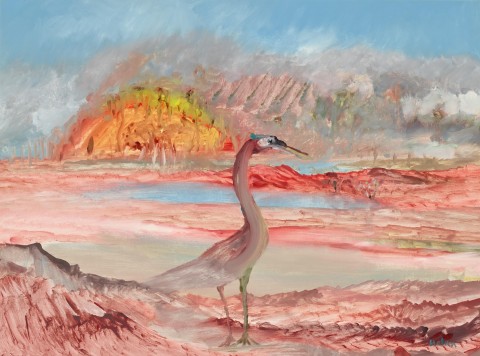BIRD IN LANDSCAPE, c.1977 – 78
SIDNEY NOLAN
oil and enamel on composition board
91.5 x 122.0 cm
signed lower right: Nolan
Private collection, UK, by descent from the artist
Christie’s, London, 11 October 2011, lot 33
Private collection, Sydney
Bird in Landscape, 1977-78, by Sidney Nolan, was painted during a period of dramatic events in the artist’s life. In December 1976, his wife Cynthia died; and the next month, Nolan’s long-time friend and collaborator, the British composer Benjamin Britten died too. Nine months later, they were joined by another artist-colleague, the poet Robert Lowell. On the positive side, in April 1976 Nolan turned sixty, an event marked by accolades and multiple exhibitions. He also reconnected with Mary Boyd, whom he had known since the 1940s, and they married in January 1978. Amidst all this, Nolan returned to an earlier sequence of paintings inspired by his travels with Cynthia through central Australia in 1948.1 Bird in Landscape may thus be interpreted as an attempt by the artist to memorialise his wife and colleagues through a fusion of memory and image.
Nolan has frequently been described as being a ‘bower bird’ in his approach to art. An inveterate traveller, he would pick up myriad inspirations wherever he went, accumulating them within his mind before reassembly as paintings. In a similar fashion, images that appeared in previous series would suddenly re-animate and jostle their way into subsequent artworks, but in new settings and utilising different techniques in their application. Nolan’s great narrative, of course, was Ned Kelly and the outlaw’s progress followed the artist’s own throughout his career. However, a multitude of birds also populate his works – emus, swans, parrots, finches, even chickens – and Bird in Landscape is a return to this theme.
Against a swirling background full of colour and painterly incident, a heron surveys an imagined landscape. Informed by Nolan’s celebration of surrealism, the bird seems to have arrived from a dream and into an uncertain land. Such a strange juxtaposition was not unusual for Nolan, and Bird in Landscape has its roots in the sequence of paintings from 1948-49 depicting central Australian pubs, mines and landscapes augmented by unnaturally large-scale birds tumbling through the air, none of whom seem able to use their wings. The bird in this image at least has its feet on the ground, and is an update of Great Heron, 1949 (private collection), set within the saltpans of Lake Eyre. This newer version is further informed by Nolan’s subsequent travels, particularly the grand images he painted after his and Cynthia’s journey to Africa in 1962. Whilst the foreground of Bird in Landscape links to the eroded furrows of Central Australia, 1950, the orange hill in the background, vanishing within a dust-storm, harks back to paintings such as African Landscape, 1963, where ‘fumes, marks or bands of intense bright colour … anchor or atmospherically envelope’ the land.2 The painting’s dream-like tenor is also informed by Nolan’s understanding of Australia’s ‘opalescent’ light, how it ‘glow(s) in transparent layers, which don’t stay as layers but flow into each other … Birds sweep by and change the colours and your eye jumps from one colour to another … sometimes with memory of the fleeting colour, the one that flashed by.’3
1. The Nolans also took Britten through central Australia in 1970.
2. Underhill, N., Sidney Nolan: a life, New South Publishing, Sydney, 2015, p.288
3. Sidney Nolan, 21 April 1978, quoted in Lynn, E. and Nolan, S., Sidney Nolan – Australia, Bay Books, Sydney and London, 1979, pp.180, 192
ANDREW GAYNOR
